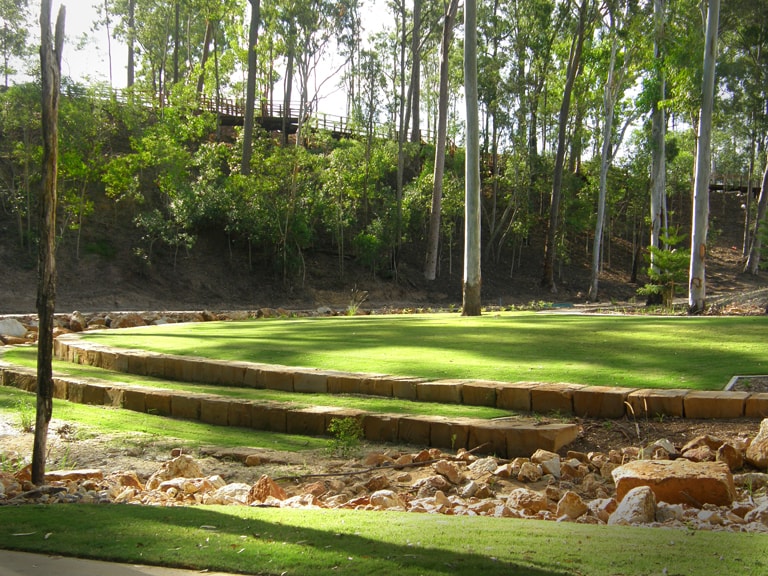Review by John Mongard FAILA for Landscape Architecture Australia 2011
South-east Queensland continues to grow, and new cities are emerging in its bushland periphery to cope with the pressure of around 66,000 people arriving every year1. Springfield is a new planned city to house an estimated 89,000 people by the year 20252, and its town centre is currently a smattering of large buildings boldly clustered around disparate retail, health, education and IT hubs.
In the middle of all this activity is a new regional park. Robelle Domain is 20 hectares of waterways and flood prone lands which skirt the new city precincts. The original Masterplan was prepared by EDAW for Springfield Land Corporation. This plan was later developed by Vee Design for Ipswich City Council and then implemented through a design and construct process with JMac Constructions.
The Vee Design Masterplan envisages a soft green heart linking three highly urbanised city quarters. It is an idea reminiscent of the early American parkways of New York and Boston by Olmstead: Build a city park and one day the city will encircle it.
As always, the beginning is not as exciting as the end point and Robelle Domain will take many years to move from picnic park to central park. It is already a weekend destination for locals looking for something to do and for somewhere to take the kids. The well integrated picnic and path facilities are the park’s bedrock for this
success.
This city is the inevitable result of the way we have built our economies: planned sites of separated land uses are far more productive and easy to build than the organic mix of old cities. Hard as one might try, the planned city looks and feels planned. In the early days, Springfield Town Centre appears dull from the outside. Does this follow for the planned regional park?
In contemporary Queensland a blend of barbeque, event and passage characterise the regional parks of the larger cities. They seek to provide a heart for large and small gatherings, offer plentiful picnic facilities, and often allow for major events and shows. A large central lawn is the soft plaza of these parks. A waterway park is usually centrally located as a magnet for kids.
The Robelle Domain fulfils these desires in a carefully considered manner and makes good use of its topography to differentiate areas in the parklands. It should easily succeed as a destination recreation park since there are enough elements to occupy families for at least half a day or more. Its fate as a central park, or as the lively centre of a city, is not so clear yet. Large distances separate the big box shopping centre precinct from the educational and mixed use city blocks. Will people walk during work and shopping time, or will they jump in cars between these areas? Not many bikes are evident in Springfield at the moment, but as the city’s apartments begin to cluster, perhaps more residents will use alternative modes and the park will then act to link the city.
The whole area of Robelle Domain was not long ago weed-infested creekways. In a period of around three to four years, these corridors have been repaired and reclaimed to be very pleasant parklands towered over by flooded gums. Bridges and boardwalks provide elevated vistas and a central promenade curves beautifully around the reconstructed waterway and lake to create a place worth visiting. Substantial amounts of water converge on the constructed waterway, and some siltation from upstream developments has occurred. This should actually assist to naturalise the park’s extensive boulder work and over time grasses will take over.
Large pyramidal lawns provide interest en route from the carpark and kids appear to enjoy running up them. Unusually large picnic shelters fold like leaves. Folded metal tables and chairs are neat, although budgetary constraints have denied some of them shade. The involvement of Council’s maintenance officers during the design process should mean that the park will be easy to look after.
The central space has a water play area with structures which are far more artful than the norm, and a new type of playground which incorporates digital and aural gaming. A cluster of sound and light towers provide nighttime displays, and mimic the flight of F1-11s, a reference to the nearby airforce base.
The kiosk and central stage are carefully sited, although the kiosk lacks landmark quality and the stage could better engage with its front lawn edge, being setback and separated by a garden. The area works well since parents can drink coffee
while watching kids play in the waterpark.
In the next stage, a denuded waterway corridor beside Orion Shopping Centre is to be converted into bold urban cascades and a major water play park. The existing cubistic waterfall, which stands somewhat isolated currently, provides an enticement to cross the parklands with the sound and movement of water and will provide a fitting end point for this urban cascade. The intended re-use of hundreds of kilolitres of cooling water from the Polaris Data Centre will be an innovative way to reduce the carbon footprint of this sculpted waterway.
Design and construct processes on large urban parks often lead to compromises of form and quality, since the contractor has to meet budget and carries large risks. Robelle Domain, with the exception of some minor details, is a skilful negotiation of budget, time and design. Much creativity is required to negotiate the journey to deliver a 20 hectare park in such a complex and time efficient process, and this is the real achievement of the project.
References
- Queensland State Government, 2011 (Medium series projections)
- http://www.greaterspringfield.com.au/FileLibrary/thebigpicture.pdf


